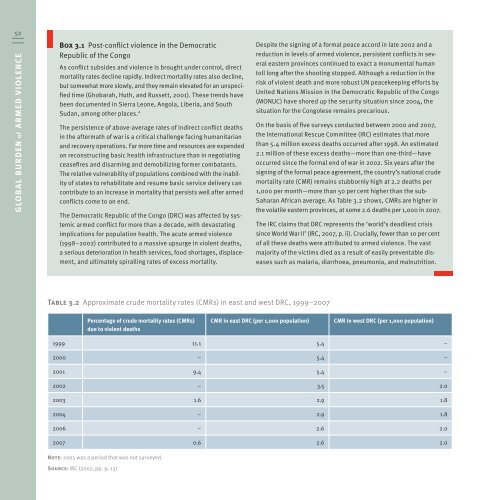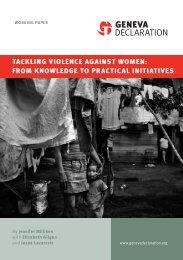Global Burden of Armed Violence - The Geneva Declaration on ...
Global Burden of Armed Violence - The Geneva Declaration on ...
Global Burden of Armed Violence - The Geneva Declaration on ...
Create successful ePaper yourself
Turn your PDF publications into a flip-book with our unique Google optimized e-Paper software.
52<br />
GLOBAL BURDEN <str<strong>on</strong>g>of</str<strong>on</strong>g> ARMED VIOLENCE<br />
Box 3.1 Post-c<strong>on</strong>flict violence in the Democratic<br />
Republic <str<strong>on</strong>g>of</str<strong>on</strong>g> the C<strong>on</strong>go<br />
As c<strong>on</strong>flict subsides and violence is brought under c<strong>on</strong>trol, direct<br />
mortality rates decline rapidly. Indirect mortality rates also decline,<br />
but somewhat more slowly, and they remain elevated for an unspecified<br />
time (Ghobarah, Huth, and Russett, 2001). <str<strong>on</strong>g>The</str<strong>on</strong>g>se trends have<br />
been documented in Sierra Le<strong>on</strong>e, Angola, Liberia, and South<br />
Sudan, am<strong>on</strong>g other places. 4<br />
<str<strong>on</strong>g>The</str<strong>on</strong>g> persistence <str<strong>on</strong>g>of</str<strong>on</strong>g> above-average rates <str<strong>on</strong>g>of</str<strong>on</strong>g> indirect c<strong>on</strong>flict deaths<br />
in the aftermath <str<strong>on</strong>g>of</str<strong>on</strong>g> war is a critical challenge facing humanitarian<br />
and recovery operati<strong>on</strong>s. Far more time and resources are expended<br />
<strong>on</strong> rec<strong>on</strong>structing basic health infrastructure than in negotiating<br />
ceasefires and disarming and demobilizing former combatants.<br />
<str<strong>on</strong>g>The</str<strong>on</strong>g> relative vulnerability <str<strong>on</strong>g>of</str<strong>on</strong>g> populati<strong>on</strong>s combined with the inability<br />
<str<strong>on</strong>g>of</str<strong>on</strong>g> states to rehabilitate and resume basic service delivery can<br />
c<strong>on</strong>tribute to an increase in mortality that persists well after armed<br />
c<strong>on</strong>flicts come to an end.<br />
<str<strong>on</strong>g>The</str<strong>on</strong>g> Democratic Republic <str<strong>on</strong>g>of</str<strong>on</strong>g> the C<strong>on</strong>go (DRC) was affected by systemic<br />
armed c<strong>on</strong>flict for more than a decade, with devastating<br />
implicati<strong>on</strong>s for populati<strong>on</strong> health. <str<strong>on</strong>g>The</str<strong>on</strong>g> acute armed violence<br />
(1998–2002) c<strong>on</strong>tributed to a massive upsurge in violent deaths,<br />
a serious deteriorati<strong>on</strong> in health services, food shortages, displacement,<br />
and ultimately spiralling rates <str<strong>on</strong>g>of</str<strong>on</strong>g> excess mortality.<br />
Table 3.2 Approximate crude mortality rates (CMRs) in east and west DRC, 1999–2007<br />
Percentage <str<strong>on</strong>g>of</str<strong>on</strong>g> crude mortality rates (CMRs)<br />
due to violent deaths<br />
Despite the signing <str<strong>on</strong>g>of</str<strong>on</strong>g> a formal peace accord in late 2002 and a<br />
reducti<strong>on</strong> in levels <str<strong>on</strong>g>of</str<strong>on</strong>g> armed violence, persistent c<strong>on</strong>flicts in several<br />
eastern provinces c<strong>on</strong>tinued to exact a m<strong>on</strong>umental human<br />
toll l<strong>on</strong>g after the shooting stopped. Although a reducti<strong>on</strong> in the<br />
risk <str<strong>on</strong>g>of</str<strong>on</strong>g> violent death and more robust UN peacekeeping efforts by<br />
United Nati<strong>on</strong>s Missi<strong>on</strong> in the Democratic Republic <str<strong>on</strong>g>of</str<strong>on</strong>g> the C<strong>on</strong>go<br />
(MONUC) have shored up the security situati<strong>on</strong> since 2004, the<br />
situati<strong>on</strong> for the C<strong>on</strong>golese remains precarious.<br />
On the basis <str<strong>on</strong>g>of</str<strong>on</strong>g> five surveys c<strong>on</strong>ducted between 2000 and 2007,<br />
the Internati<strong>on</strong>al Rescue Committee (IRC) estimates that more<br />
than 5.4 milli<strong>on</strong> excess deaths occurred after 1998. An estimated<br />
2.1 milli<strong>on</strong> <str<strong>on</strong>g>of</str<strong>on</strong>g> these excess deaths—more than <strong>on</strong>e-third—have<br />
occurred since the formal end <str<strong>on</strong>g>of</str<strong>on</strong>g> war in 2002. Six years after the<br />
signing <str<strong>on</strong>g>of</str<strong>on</strong>g> the formal peace agreement, the country’s nati<strong>on</strong>al crude<br />
mortality rate (CMR) remains stubbornly high at 2.2 deaths per<br />
1,000 per m<strong>on</strong>th—more than 50 per cent higher than the sub-<br />
Saharan African average. As Table 3.2 shows, CMRs are higher in<br />
the volatile eastern provinces, at some 2.6 deaths per 1,000 in 2007.<br />
<str<strong>on</strong>g>The</str<strong>on</strong>g> IRC claims that DRC represents the ‘world’s deadliest crisis<br />
since World War II’ (IRC, 2007, p. ii). Crucially, fewer than 10 per cent<br />
<str<strong>on</strong>g>of</str<strong>on</strong>g> all these deaths were attributed to armed violence. <str<strong>on</strong>g>The</str<strong>on</strong>g> vast<br />
majority <str<strong>on</strong>g>of</str<strong>on</strong>g> the victims died as a result <str<strong>on</strong>g>of</str<strong>on</strong>g> easily preventable diseases<br />
such as malaria, diarrhoea, pneum<strong>on</strong>ia, and malnutriti<strong>on</strong>.<br />
CMR in east DRC (per 1,000 populati<strong>on</strong>) CMR in west DRC (per 1,000 populati<strong>on</strong>)<br />
1999 11.1 5.4 –<br />
2000 – 5.4 –<br />
2001 9.4 5.4 –<br />
2002 – 3.5 2.0<br />
2003 1.6 2.9 1.8<br />
2004 – 2.9 1.8<br />
2006 – 2.6 2.0<br />
2007 0.6 2.6 2.0<br />
Note: 2005 was a period that was not surveyed.<br />
Source: IRC (2007, pp. 9, 13)









